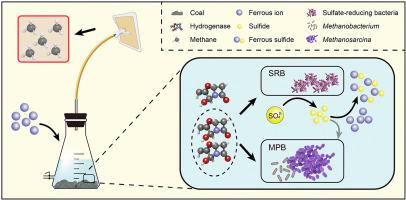Gas Science and Engineering Pub Date : 2021-04-06 , DOI: 10.1016/j.jngse.2021.103959 Daping Xia , Song Huang , Xiatong Yan , Ruifu Yuan

|
The conversion of coal to biomethane is gaining considerable attention and can play a significant role in the field of energy research. To study the underlying influencing mechanism of adding exogenous Fe2+ on the process of the conversion of coal to biomethane, the biomethane production experiments were conducted using lignite and bituminous coal A as the substrate, and supplemented by different concentrations of ferrous ions. It is found that the optimum concentration of Fe2+ in the process of producing biomethane from coal is 10 mg/L. At this time, the cumulative methane production of lignite increased from 192 mL to 246 mL, and that of bituminous coal A increased from 165 mL to 197 mL, which increased by 13.5% and 10.8%. The added Fe2+ increased the content of iron in the humic acid state, which was easily absorbed and effectively utilized by microorganisms. This increase promoted the synthesis of hydrogenase and advanced the activity. Iron in the humic acid state also participated in the enzymatic reaction and promoted the activity of sulfate reducing bacteria and methanogens. Fe2+ in the free state formed FeS precipitates with the sulfur ion, which reduced the toxicity of soluble sulfides to bacteria. In both treated and untreated samples, the dominant methanogenic archaea changed from Methanobacterium before anaerobic fermentation to Methanosarcina after the reaction, indicating that Methanosarcina was favored under iron-abundant conditions. The experimental results improve understanding of the mechanism through which the addition of Fe2+ promotes the conversion of coal to biomethane.
中文翻译:

Fe 2+对煤制生物甲烷的影响机理
煤炭向生物甲烷的转化正受到广泛关注,并可以在能源研究领域中发挥重要作用。为了研究在煤转化为生物甲烷过程中添加外源Fe 2+的潜在影响机理,以褐煤和烟煤A为底物,并辅以不同浓度的亚铁离子进行了生物甲烷生产实验。发现从煤生产生物甲烷的过程中,Fe 2+的最佳浓度为10 mg / L。此时,褐煤的甲烷累积产量从192 mL增加到246 mL,烟煤A的甲烷产量从165 mL增加到197 mL,分别增加了13.5%和10.8%。添加的Fe 2+增加了腐殖酸状态下的铁含量,易于被微生物吸收和有效利用。这种增加促进了氢化酶的合成并提高了活性。腐殖酸状态下的铁也参与了酶促反应,并促进了硫酸盐还原细菌和产甲烷菌的活性。游离态形成的Fe 2+与硫离子一起沉淀形成FeS,从而降低了可溶性硫化物对细菌的毒性。在处理和未处理的样品,占主导地位的产甲烷古从改变甲烷厌氧发酵之前甲烷反应后,表明甲烷在铁丰富的条件下受到青睐。实验结果使人们更加了解添加Fe 2+可以促进煤转化为生物甲烷的机理。











































 京公网安备 11010802027423号
京公网安备 11010802027423号